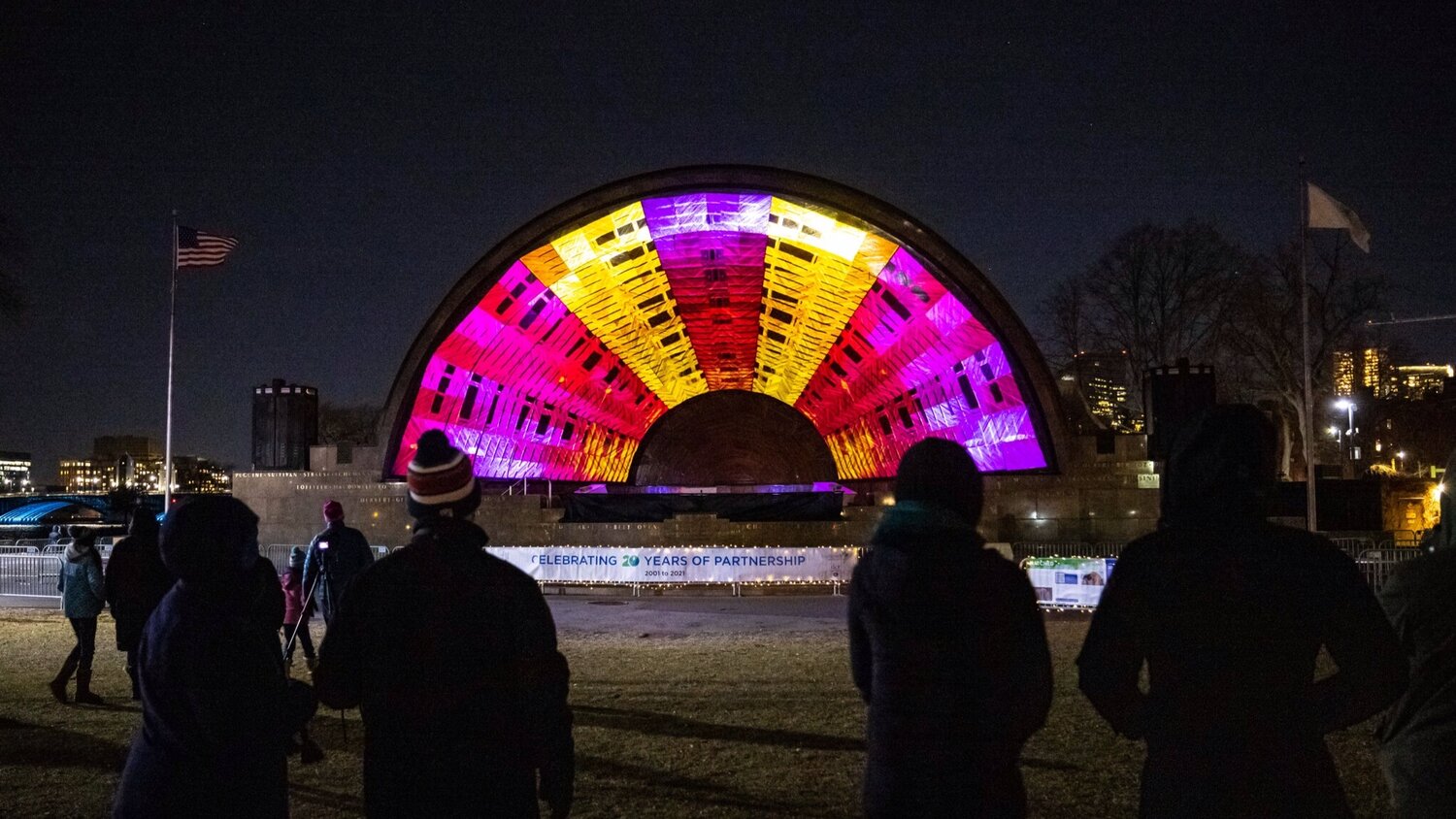Maria Finkelmeier is a self described percussionist, composer, and creative catalyst. And, fortunately for us, a TEA Creative Parter. Annie sat down with Maria to talk about creative collaboration, listening, and the drum set she inherited from her older brother. Here are excerpts from their conversation.
Annie: How do you describe the work that you do? When someone says to you, Maria, what do you do for a living? What do you say?
Maria: I live a project based lifestyle in which I create (often) site-specific work that marries multi disciplines. I’m a percussionist and composer. So all of my work comes from the foundation of a Sonic space. I think about sound, music, exploration. But that often catapults into other ideas and disciplines. I’ve been doing a lot of light and projection and visual thinking, and I’m very attracted to multi-sensory experiences. Even if I’m staging a more traditional “concert experience”, I’m still thinking deeply about how a person comes to the door. How do they find their space? What does the space feel like? How does it welcome people? I do like to curate that experience from 360 degrees. But I also love the kind of unknown elements that occur in the public space.
Annie: Does your work on sound tend to conjure imagery or memories for you?
Maria: Yeah, definitely. I’m going to struggle a bit to explain, but I always need a story or a seed or a building or a park or a history or a poem. I feel that my compositions or improvisations always come from something that is more tangible or visual or in the world. I also think very much about emotional trajectory. So I think that coincides with a visualization. Sometimes the sound guides and I’m just really in the space. I think when I’m most lost in my head is the best; when I’m actually in that moment of flow. I’m really always aligning whatever thing, whatever musical experience I’m creating, to something that is visual. I don’t have synesthesia where I can see color from sound–it’s not that one-to-one–but there is definitely visual abstraction happening in my head when I’m writing.
Annie: When you are in that sort of space, do you come back to things; visions or people or feelings? Are there themes or “old friends” that return, even if the inspiration is different every time?
Maria: For sure, because there’s definitely melodies or grooves, especially grooves, or feels that are just part of my language. Even if I really try to go against them… like I’m going to really try to rip apart my voice, just do something totally different. You’ll always get these nuggets of familiarity. And I think that’s how musicians and composers find our voices; by embracing those nuggets. So I think there are definitely home places that emerge, maybe subtly in some pieces or maybe very apparent in others that are aligned with that sense of home. I play marimba and drums. So there’ll be moments where my hands are moving and I’m not thinking; it’s just very fluid. Those are the home spaces.
Annie: Can you tell me about your background or your childhood specifically? What put you on this professional road? How did you end up here?
Maria: My origin story is deeply steeped in music. I’m not from a musical family necessarily, but my parents put my brother and I in piano lessons when we were really young. I had a pretty natural association with instruments, which is great. And when my brother started drums–he’s five years older–my parents bought the drum set. So when I had to pick an instrument for school band, they said, “you need to play drums because we don’t want to purchase another instrument”. Plus it’s fun and I thought it was really cool. I think I was attracted to the drums because you can do a lot of things with them.
Diving into all these different cultures and understanding of how music has played a role in drumming specifically; there’s such depth to the repertoire and literature and history. It aligns with my fascination with many artistic practices. How do they all come together? I was building drum setups early on. So there’s always been a comfort with creating, figuring it out, troubleshooting. I think that has given me a great foundation of skills that have allowed me to be brave, to just figure it out. I think risk doesn’t intimidate me so much because percussion as a kind of a modern instrument family is new and we’re developing it as we go.
Annie: Do you feel percussion hasn’t been given its due? I feel like it’s so critically important actually, in every way. It’s foundational to making music, like even if you’re just tapping a foot.
Maria: I would say that it is a part of our lives. The striking of material is the most ancient instinct of our species. However, as a contemporary practice, I think it’s a little intimidating because it can be very abstract and it can be so vast. When it comes to presenting organizations, they’re like, where do we put Maria? Because percussion can be anything, right? It’s hard to sell something and hard to talk about something that can be anything.
Annie: Do you hear percussion in your life all the time? How attuned is your ear as you move through the world? Do you tend to notice percussive sound as you wander around the planet?
Maria: Yeah, I would say I’m kind of making patterns as I go, because really what is, what is music in general? It’s patterns of sounds and the way you organize those patterns is the way the music is conjured. I’m hearing layers. I think a lot of musical ears hear and then combine surrounding sounds in ways. It’s not manifesting a symphony in my brain, but I do love to listen. And for me actually, I see things and I wonder what they sound like. That’s probably where my curiosity goes most often.
Annie: I was just thinking about the layers of sound and being able to tell sounds apart… which we don’t necessarily do or, and some people can’t.
Maria: That’s such an interesting statement because we do hear and listen differently. You think our ears function the same, but they don’t. And there’s different ability levels; the way sound enters into our space, we translate that based on our experience. That’s really fascinating to me. I can perform a concert and I can get 500 different interpretations. That’s wild because you’re there and you think you know what it sounds like. But you’re basing that on your experience; what you did that day, your emotional space.
Annie: I think there’s something really interesting about that idea of listening from the receiver side. What does that listening look like? Or what does it mean? It’s a communication right? Between you and your audiences. You’re sending a message out with your piece and they’re receiving it in a very specific way.
Maria: Yeah, exactly. I can try to express my story or what I’m trying to say. I try, but it’s up to the receiver to take it in. That’s scary, but exciting.
Annie: It’s also a question of impact, right? How does what you make have impact in the moment and also outside of the moment? How many people out there are just listening to things that you’ve made?
Maria: The music I make is more… I’m not cutting albums every day, which I think if you’re an artist that’s doing that, you’re kind of used to not knowing where the listener is. But for the type of work that I do, (that’s more project based) the idea that the music is living on is really exciting. I’m really attracted to ephemeral work because I like the opportunity to create memory that has a finite space. We need things to have a beginning and an end in order to digest them in ways that offer some reflection. So the idea that we created a work that lived for a certain amount of time, and now there’s music or maybe photos that can take an audience back to that place, I think is pretty exciting.
Annie: I’ve been thinking a lot about collaboration lately. Are there collaborations that work better for you or that you prefer to cultivate?
Maria: I think collaboration is innately human centric and skill based. So the collaboration starts with people figuring out what their strengths are. I’m a trusting person. So sometimes I have to go through bad collaborations to find good collaborations. And when I find those good people, I want to hang on to them. But I also think it’s important to be dynamic because you want to continue to be challenged. Part of what I love about collaboration is that I get to learn new things. So I want to work with people that can bring skills, perspectives, and history that are different from my own to then expand what I think could even be possible.
I also think that to make the impact I strive to make, especially in large scale works, I can’t do it alone. It’s impossible. Because making that impact takes a team. And I know that, and I’ve known that for a long time. I like to work with people that are really positive and kind. I also think vulnerability is really special. I need my team to sit down and say, okay, here’s what I can do. Here’s what I don’t know about. I know we need to figure it out, so let’s figure it out together and here’s how we’re going to get there. Allowing for trust in one another through vulnerability, I think is really important.
Photo above by Aram Boghosian


